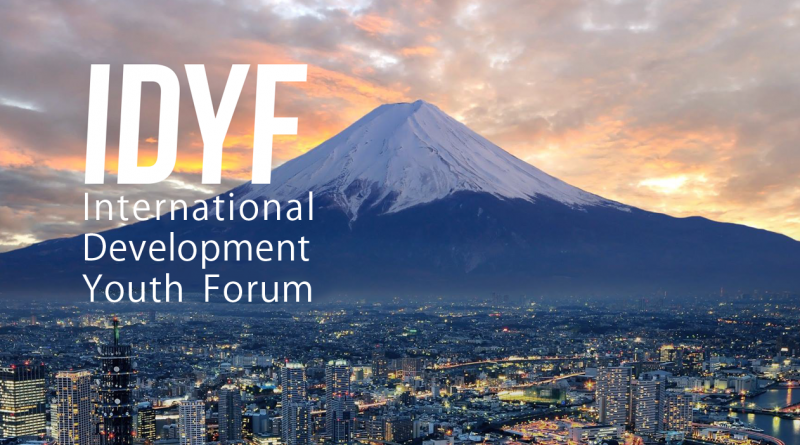[Nhật Bản] Cơ Hội Tham Dự Diễn Đàn Phát Triển Thanh Niên Quốc Tế 2017 - International Development Youth Forum Tại Tokyo
IDYF 2017 Program Overview
| Official Event Name | International Development Youth Forum2017 |
| Term | Sunday 12th March 2017 – Sunday 19th March 2017 |
| Place | Youth Education National Olympics Memorial Youth Center in Tokyo |
| Eligible Age | 18-28 years old |
| Language | English |
| Country of Origin | Any nationalities are eligible for IDYF2017 |
| Participation Fee | JPY 25,000
(covering Foods and Dormitory during the forum/NOT Including the sightseeing fee) |
Theme for IDYF2017
What IDYF2017 Aspires to Achieve
“What Is Development? Where Are We Heading?”
Based on our mission to “Design Our Future”, IDYF2017 aspires to redetermine the meaning of ‘development’. Selected participants from all over the world will be invited to discuss what each of us conceive an ideal society and common goals are, in order to draw feasible solutions to provided case studies.
The term ‘development’ has been treated with various definitions and ideas, such as economic growth, social progress, and community development. Different cultural backgrounds, experience, and occupations shape different individual values toward development, and lead to diversity in its ideal goal. Due to this complexity, problems in the field of development would not be solved without the collaborative efforts of individuals and groups. Hence, it is indispensable that those youth, who will play leading roles in the future development fields, share their views and discuss what development is.
IDYF provides the opportunities to gather and cultivate the ability to understand various forms of ideal ‘development’, for world youth who are inspired to make changes in the development fields, by working together toward a mutual goal.
Discussion Theme for IDYF 2017
“Corporation and Development”
Approximately 70% of all capital flowing into developing countries as a result of economic globalization consists of private investments, although ODA is also included as one of the capital flow in that statistics. Corporate activities are rapidly strengthening presence by bringing economic benefits, technological transfers, and job creations. However, they cause problems such as labor exploitation, environmental disruption, and cultural tensions. These are becoming ever more prominent, as varying definitions of ‘development’ are beginning to find recognition.
Therefore, as architects of future development, world youth from around the globe will meet in this forum to discuss the nature of development, including its goals and the roles of multinational corporations, in order to create a new vision for ‘development’ that addresses the limitations of our current economic system.
Case Studies
- Garment Industry in Bangladesh
Bangladesh has the third largest export of apparel products in the world and is called China Plus One, which means, a lot of industries including garment are moving their production bases from China to Bangladesh as its cost is only one fifth of that in China. 60% of these apparel products are exported to Europe and 23% to North America. Although the garment industry contributes to Bangladesh’s development to a certain level, it does produce several issues. For instance, around 70% of the workers in the garment industry are women (or children) and they suffer from physical and sexual abuse. Unrecognizable number of people are receiving less than the minimum wage. Industrial disaster, such as fire in Tazreen factory and the collapse of Rana Plaza, caused more than 100 or 1000 deaths respectively. In order to solve these problems, the owners and their apparel companies must pay close attention not only to the conditions or rights of the workers at the factories, but to every step in the supply chain process of their products.
- Soybean Industry in Brazil
Soybean production has contributed significantly to the country’s development in Brazil. Currently, Brazil is the second largest soybean producer in the world and soybean is the second largest product in Brazilian exports. On the other hand, soybean production engenders continuous controversy. Some argue that the expansion of soybean fields causes environmental damage, and that the overproduction of soybean jeopardizes food security of the poor. More recently, critics argue that “land grabbing” by transnational agribusiness deprived land ownership of the local farmers. Furthermore, Brazil currently endeavours to transplant their capitalistic agricultural model to Mozambique under the guidance of Japanese companies and government. However, this is facing a strong resistance from the local population. Thus, the relationship between soybean and Brazil has always been complex and entangled, providing a number of important challenges we must consider for future sustainable development.
- Cut Flowers Industry in Kenya
Kenya is one of the leading exporter of cut flowers, which started in the 1970s. Today, the country exports their cut flowers to over 60 countries, mainly to European countries and Japan. Floriculture is now the fastest growing sector in the Kenyan economy, providing employment to an estimated number of 50,000 workers. However, behind the success of the global growth of cut flower industry, it has been criticized for its poor labor environment, sexual assault towards female workers, unequal power balance within the cut flower association, complicated supply chain exploiting local producers and many more. Based on this case study, participants will be required to discuss what solutions for ‘development’ there is for Kenyan cut flower industry, including Kenyan locals and the companies/agencies outside of Kenya.
Detailed Plan for Activities
*The program schedule is subject to change
4,767 lượt xem

